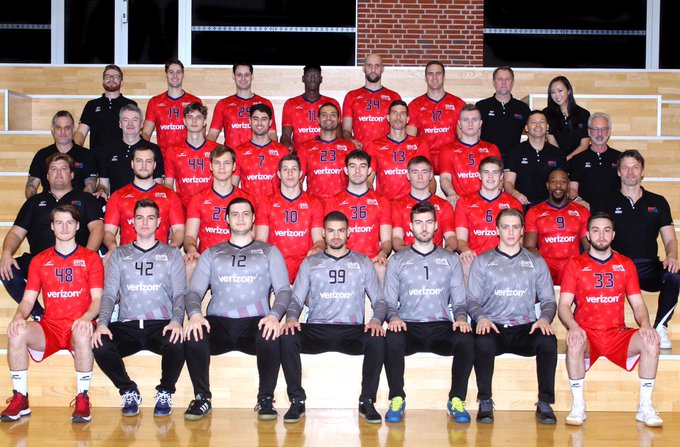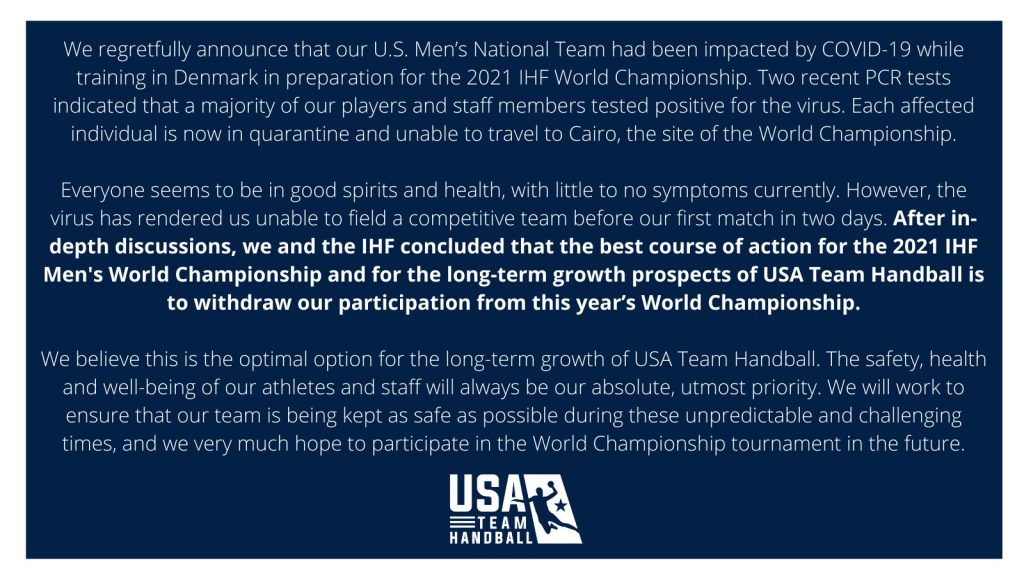Summary page of all USA news and commentary related to the 2021 IHF Men’s Handball World Championship: Link
A Missed Benchmarking Opportunity
Participation in a major handball tournament is often a point for further discussion. An opportunity to assess where a program currently stands and where it might be headed. Most definitely, the U.S. Men’s participation in a World Championships for the first time in 20 years would have been such an opportunity. Alas, due to multiple positive COVID test results such benchmarking didn’t get to take place. However, that doesn’t preclude me from providing some informed speculation as to what might have happened.
Projected Team USA Results (Assuming our Full Roster had been Available)
As someone who has seen almost every match the U.S. has played in the past two years I feel that I’ve a pretty good idea of what they were “capable” of achieving and I was really looking forward to the prospect of Team USA surprising the Handball world. I say “surprising” because the expectations of most people were pretty low based on past results that simply weren’t very relevant anymore. In particular, much was written about how Greenland had performed historically better in North American Championships, but such writeups also neglected to mention that the U.S. roster had recently added several accomplished dual citizens to its roster.
Overall, with these new roster additions, I would assess that the U.S. is roughly comparable now to a 2nd Division German Bundesliga team. A big part of this logic are two of those additions, Ian and Patrick Hueter, who both start for Dormagen, currently in 4th place in that league. If one substitutes the other positions at Dormagen with athletes like Drew Donlin (Leon) and Alex Chan (Cisne) who play in the Liga ASOBAL, Pál Merkovszki who plays in Hungary’s top division (Gyöngyösi KK) and Abou Fofana (Angers SCO) in France’s 2nd division, I essentially see another HBL 2 team, perhaps a bit further down in the standings. Further down because our wings and backups at other positions are playing for lower level clubs in Europe. Still some very capable players, but just a notch lower in talent.
And, while a middle of the pack, 2nd Division Germany team would have had little hope against teams like Norway and France, such a side would have done fine vs many of the teams in the President’s Cup. And, if the U.S. had played really well and gotten some luck, they could have even beat Austria, a side that might be comparable (with their 2 top backcourts missing) to an all star 2nd Division Bundesliga side. I’m not in any way saying such a victory would have happened, just that it wasn’t as crazy a proposition some people thought it was.
For a more detailed analysis of the U.S. 20 man roster check out this previous post: Link
Taking into account the relative strength of the U.S. roster and their would have been opponents here is my assessment of how likely each team would have won a head to head matchup
- Preliminary Group E
- USA (10%) vs Austria (90%)
- USA (<1%) vs Norway (>99%)
- USA (<1%) vs France (>99%)
- President’s Group II
- USA (60%) vs Morocco (40%)
- USA (15%) vs Chile (85%)
- USA (75%) vs S Korea (25%)
- Placement Match (would have been one of the following)
- For 25th: USA (10%) vs Tunisia (90%) or
- For 27th: USA (60%) vs DR Congo (40%) or
- For 29th: USA (40%) vs Angola (60%) or
- For 31st: USA (win by forfeit) vs Cape Verde
Team USA Results (Assuming our Full Roster had NOT been Available)
It’s worth noting, that the U.S., according to press reports, briefly considered sending a significantly weaker roster to the World Championships after several players tested positive for COVID-19. This roster would have consisted of 12 players that had tested negative with the addition of 8 more athletes from the provisional roster that hadn’t been at the training camp.
I don’t know the exact composition of who would have been on this revamped roster, but U.S. Head Coach, Robert Hedin, is quoted as saying we didn’t have any defense. That could be interpreted in a number of ways, but I’ll interpret it to mean that it wasn’t clear who our goalkeeper would be and that most of our stable of 6’4″ plus defenders in the middle 4 positions would be unavailable.
While I respect the hard work and effort of all of the athletes on our 35 man provisional roster, there’s a considerable drop off in talent after the first 10 or so players. I would assess that a U.S. team missing several key players would not have won any matches and I suspect some of the losses could have been major blowouts in the 30 goal range. Again, it’s hard to say without seeing exactly who would have been available. But, keep in mind, that most, if not all of the 8 athletes that would have been added had not, due to the pandemic, even played handball for several months. Further, there probably would have been even more positive test results after the team arrived in Egypt that very likely would have resulted in a Cape Verde situation with limited athletes available and an eventual withdrawal from the tournament.
In short, it would have been a very bad look for a U.S. team returning to the world stage. I don’t know how everything was factored into the U.S. decision to withdraw, but this announcement does indicate that the U.S. would have been unable to field a competitive team prior to the first match vs Austria.
Benchmarking the USA Team
So, assuming that the U.S. had been able to send a full roster what would have been the overall assessment? Well, this largely becomes an assessment of how the U.S. would have performed in all of their matches. Using the expected win percentages of individual matches above here’s my qualitative assessment of how the U.S. might have fared overall:
- Spectacular: Upset over Austria or Winning the President’s Cup; Further, surprisingly competitive matches against top teams like France and Norway.
- Great: 3 wins (S Korea, Morocco and RD Congo) for 27th place
- Average: 2 wins (S Korea and then either Morocco or Angola) for either 28th or 29th place
- Disappointing: 1 win (S Korea) and 30th place
- Disaster: No wins and 31st place only because Cape Verde had forfeited
There are so many variables and circumstances to consider here that it would be an increasingly speculative narrative to guess what might have happened. With that in mind, I’ll benchmark with what I think was the most likely outcome: 2 wins in the President’s Cup.
But narratively, there would have been a lot more to talk about than those 2 wins. I think the U.S. would have first performed respectively in the Preliminary Group, perhaps giving Austria a good match before a run of turnovers put the match out of reach. Against France and Norway there would never have been any doubt as to the outcome, but there would also been sequences of good play where folks watching the match would have said, “These Americans are competing. They’re making France/Norway work a little here.”
In the President’s Cup against teams with similar individual talent levels, there would have been more revelations especially with the U.S. picking up a couple of wins and showing further improvement and cohesiveness as a team.
By the end of the tournament, the consensus of most would be that this was a U.S. team that had shown they could play some real handball. Further, thanks to a relatively young roster and an Olympic Games in 2028, it was a side with strong potential for further improvement.
We’ll Never Know… but there’s a Point to this Speculation
Frustratingly, we’ll never know what would have actually happened. So, you might rightly argue what’s the point of this speculation?
Well, the point is that whether folks realize it or not some major decisions will need to be made in the not too distant future regarding the future direction of the U.S. Men’s National Team Program. These decisions will center around how to make the U.S. team more competitive and how much should be spent to make that happen.
And, what does the U.S. want to officially make happen? Well, according to the USA Team Handball Strategic Plan the U.S. wants to finish in the top 12 at the 2023 World Championships, qualify for the 2024 Olympics and finish in the top 6 at the 2028 Olympic Games: Link
Is that realistic? I’ve got my doubts: Link But, regardless if one is going to plan for the future you really, really need to benchmark where you currently stand first. How else can one even begin to project what “more” is needed if you don’t understand what you have?
It would have been far better to have the definitive benchmark of actual competition, but lacking that informed speculation is the next best thing.
So, it’s not perfect, but we’ve got an idea now of “what we have”. In part 2, I’ll address what’s needed to further improve the U.S. Men’s National Team.

